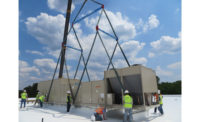“We are a very diverse company, so when we met Blueprint Energy Group while researching a geothermal system last year, I was intrigued to see that there was a micro CHP unit in the house,” said Burrell. “I had seen CHP units in commercial applications before, but I’d never seen one on the residential side.”
Burrell decided that this new energy-saving technology would not only benefit his customers but would provide another way to distinguish his 87-year-old company from the competition. With three installations under his belt and several more in the works, Burrell believes that offering micro CHP units has been one of the smartest moves he’s ever made.
How It Works
CHP systems (also known as cogeneration systems) are well known in the commercial world, where they provide thermal energy for buildings or processes while simultaneously generating part of the electricity needed at the site. Now they are making inroads into the residential/light commercial market, with manufacturers introducing micro CHP systems, such as the CP10WN unit from Yanmar, which Burrell offers.
This micro CHP system is, in essence, a natural gas high-efficiency generator that utilizes the heat generated from the liquid-cooled engine to heat buildings, swimming pools, radiant in-floor heat, domestic hot water, etc. As Burrell noted, “Anything that a boiler is capable of heating, we can use this unit to do a similar function.”
The benefit to using the micro CHP system over a hot water boiler alone is that it can produce 10 kW of electricity, which covers approximately 80 percent of the electricity needs of Burrell’s customers. It also comes in handy during emergency situations in which there is no power. “A system was installed in a home in Connecticut last year, and when Hurricane Irene came through, the town was without power for a week or so, but the home never lost power, thanks to the micro CHP unit.”
Currently, Yanmar’s micro CHP system is only available in the 10-kW size, which is best used for homes and light commercial structures that are 6,000 square feet and larger. Later this year, a 5-kW unit is expected to become available, which can be used for homes in the 3,000- to 6,000-square-foot range. The units measure 30 inches wide by 5 feet deep by 6 feet high and require 2 feet of clearance on each side. Multiple units can be installed together, provided there is sufficient space available inside. Burrell noted that while the units are often installed outside in Japan, he only installs them inside, where they are protected from the elements.
The units are installed per the National Fuel Gas Code, and venting is similar to that used for a high-efficiency boiler. “The flue products are similar to a condensing boiler,” said Burrell. “What is different is that there is engine exhaust, which must be ducted directly outside. A fresh air intake is also required, and we work with Lippolis Electric to implement the electrical side of the installation.”
Besides those considerations, Burrell noted that installing a micro CHP unit is fairly straightforward in both new construction or retrofit applications. “We often install very sophisticated systems, so it’s a relief to install this complex machine, which runs off a very basic control system that is easy for the homeowner to use. Routine maintenance depends on run hours, and the system sends us an email about a month before service is due.”
Making the Sale
As can be expected, Yanmar’s 10-kW micro CHP system is still very expensive for most homeowners, ranging anywhere from $70,000 to $90,000, with expected returns within three to six years. When paired with a geothermal system, which is how Burrell has installed them up to this point, the total cost can exceed $200,000 for an installation, yet customers continue to be very interested in the technology.
“Believe it or not, in the right situation, these units have not been difficult to sell, because many of our customers are very interested in energy savings right now, as well as being green,” said Burrell. “We have a whole process we go through when putting together a bid. We take a year’s worth of energy bills to figure out what size is needed, how the unit(s) will operate, and what the return on investment (ROI) will be. We also explain that the micro CHP units come with warranties that can extend to 10 years and that the 75 units that were installed 14 years ago are still running.”
Energy savings is the biggest selling point, said Burrell, who points out that one installation produces 10 kW of electricity at roughly $.06/kW, compared to the utility rate of $0.22/kW. “The system basically cut one homeowner’s energy bills by 70 percent.” He notes that when the unit is paired with a geothermal system, the 30 percent tax credit helps reduce the payback period greatly.
“The costs are high right now, but in five or six years, I think the prices will come down, similar to what happened with home computers,” said Burrell. “This is the future, though, and it’s been a great benefit to my company. We’ve been exposed to different builders and architects and in two instances, the micro CHP unit was the wild card that sold the job. It has definitely diversified our business and helped us out. It’s a no-brainer for us to be involved with it.”
Publication date: 6/18/2012











